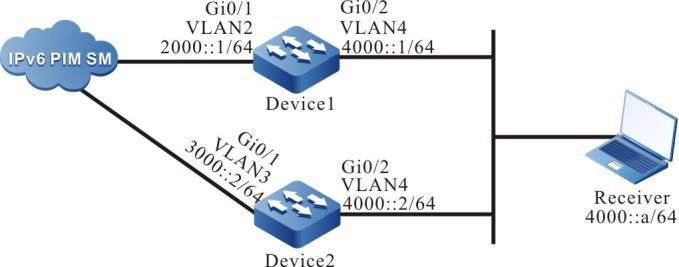Configure MLD Basic Functions Example
Network Requirements
- The whole network runs the IPv6 PIM-SM protocol.
- Device1, Device2, and Receiver are in the same LAN and Device1 is the querier.
- Receiver is one receiver of Device1 and Device2 stub network.
- Run MLDv2 between Device1, Device2 and stub network.
Network Topology

Figure 9-1 Networking of configuring MLD basic functions
Configuration Steps
Step 1: Configure VLAN, and add the port to the corresponding VLAN (omitted).
Step 2: Configure the IPv6 address of the interface (omitted).
Step 3: Globally enable the IPv6 multicast forwarding and enable the multicast protocol IPv6 PIM-SM on the interface. Enable MLD on the interface of Device1 and Device2 connecting the Receiver.
#Configure Device1.
Globally enable the IPv6 multicast forwarding, enable the multicast protocol IPv6 PIM-SM on the related interfaces, and enable MLD on the interface of connecting Receiver.
|
Device1#configure terminal
Device1(config)#ipv6 multicast-routing
Device1(config)#interface vlan2
Device1(config-if-vlan2)#ipv6 pim sparse-mode
Device1(config-if-vlan2)#exit
Device1(config)#interface vlan4
Device1(config-if-vlan4)#ipv6 pim sparse-mode
Device1(config-if-vlan4)#ipv6 mld enable
Device1(config-if-vlan4)#exit
|
#Configure Device2.
Globally enable the IPv6 multicast forwarding, enable the multicast protocol IPv6 PIM-SM on the related interfaces, and enable MLD on the interface of connecting Receiver.
|
Device2#configure terminal
Device2(config)#ipv6 multicast-routing
Device2(config)#interface vlan3
Device2(config-if-vlan3)#ipv6 pim sparse-mode
Device2(config-if-vlan3)#exit
Device2(config)#interface vlan4
Device2(config-if-vlan4)#ipv6 pim sparse-mode
Device2(config-if-vlan4)#ipv6 mld enable
Device2(config-if-vlan4)#exit
|
Step 4: Check the result.
#View the MLD version information and querier election result of Device1 interface vlan4.
Device1#show ipv6 mld interface vlan4
Interface vlan4 (Index 23)
MLD Enabled, Active
Querier: fe80::201:2ff:fe03:406 (Self)
Default version: 2
Querier parameter:
Query interval is 125 seconds
Querier timeout is 255 seconds
Query response time is 10 seconds
Last member query response interval is 1 seconds
Last member query count is 2
Group Membership interval is 260 seconds
Robustness variable is 2
#View the MLD version information and querier election result of Device2 interface gigabitethernet0/0/1.
Device2#show ipv6 mld interface vlan4
Interface vlan4 (Index 50331674)
MLD Enabled, Active
Querier: fe80::201:2ff:fe03:406
Non-Querier: fe80::201:7aff:febc:662b Expires: 00:04:07
Default version: 2
Querier parameter:
Query interval is 125 seconds
Querier timeout is 255 seconds
Query response time is 10 seconds
Last member query response interval is 1 seconds
Last member query count is 2
Group Membership interval is 260 seconds
Robustness variable is 2
# Receiver sends the MLDv2 member report packet to add to multicast group FF1E::1.
# View the multicast member table of Device1.
Device1#show ipv6 mld groups
MLD Connected Group Membership
Total 1 Connected Groups
Group Interface Uptime Expires V1-Expires Last Reporter
ff1e::1 vlan4 00:00:02 00:04:17 not used fe80::b
#View the multicast member table of Device2.
Device2#show ipv6 mld groups
MLD Connected Group Membership
Total 1 Connected Groups
Group Interface Uptime Expires V1-Expires Last Reporter
ff1e::1 vlan4 00:00:02 00:04:17 not used fe80::b

-
On the interface, run the MLDv2 version, be compatible with the MLDv1 member relation report and MLDv1 member leave packet by default. You can configure the running MLD version of the interface via the command ipv6 mld version.
- When multiple devices run MLD in one LAN, elect the MLD querier and the one with the smallest address is elected as the MLD querier of the LAN.
 Switch
Switch Wifi - Access Point
Wifi - Access Point Firewall
Firewall Router
Router Module Quang
Module Quang![Module Quang Cisco]() Module Quang Cisco
Module Quang Cisco![Module quang HPE]() Module quang HPE
Module quang HPE![Module quang Maipu]() Module quang Maipu
Module quang Maipu![Module quang Brocade]() Module quang Brocade
Module quang Brocade![Module quang Fortinet]() Module quang Fortinet
Module quang Fortinet![Module quang Aruba]() Module quang Aruba
Module quang Aruba![Module quang OEM]() Module quang OEM
Module quang OEM![Module quang Juniper]() Module quang Juniper
Module quang Juniper![Module quang Dell]() Module quang Dell
Module quang Dell![Module quang Palo Alto]() Module quang Palo Alto
Module quang Palo Alto![Module quang Huawei]() Module quang Huawei
Module quang Huawei![Module quang Arista]() Module quang Arista
Module quang Arista![Module quang F5]() Module quang F5
Module quang F5![Module quang H3C]() Module quang H3C
Module quang H3C![Module Quang Allied Telesis]() Module Quang Allied Telesis
Module Quang Allied Telesis![Module quang SonicWall]() Module quang SonicWall
Module quang SonicWall![Module quang Mikrotik]() Module quang Mikrotik
Module quang Mikrotik![Module quang Handar]() Module quang Handar
Module quang Handar Máy chủ (Server)
Máy chủ (Server) Thiết bị lưu trữ (SAN, NAS)
Thiết bị lưu trữ (SAN, NAS) Load Balancing
Load Balancing Video Conferencing
Video Conferencing Phụ kiện máy chủ
Phụ kiện máy chủ Thiết Bị IoT
Thiết Bị IoT Phụ Kiện Mạng
Phụ Kiện Mạng




.png)
























